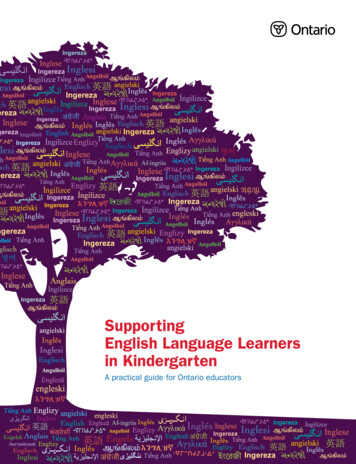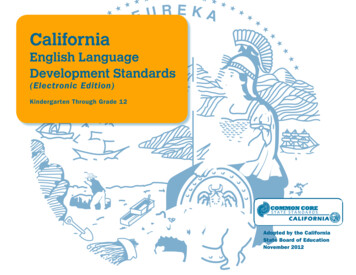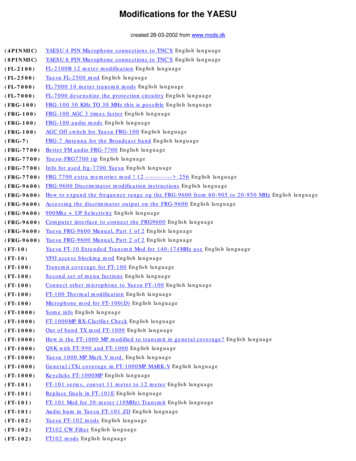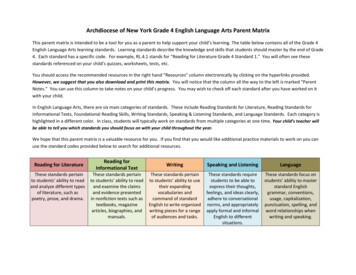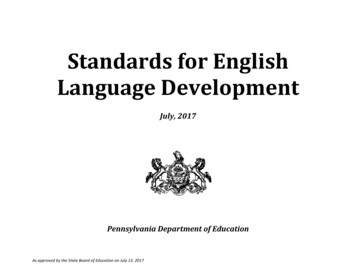
Transcription
Standards for EnglishLanguage DevelopmentJuly, 2017Pennsylvania Department of EducationAs approved by the State Board of Education on July 13, 2017
TABLE OF CONTENTSIntroduction.1Grade Level Pre-K-Kindergarten: English Language Development Standards .2Social and Instructional .2Language Arts .3Mathematics .4Science .5Social Studies .6Grade Level 1: English Language Development Standards .7Social and Instructional .7Language Arts .8Mathematics .10Science .11Social Studies .12Grade Level 2-3: English Language Development Standards .13Social and Instructional .13Language Arts .14Mathematics .16Science .17Social Studies .18Grade Level 4-5: English Language Development Standards .20Social and Instructional .20Language Arts .22Mathematics .23Science .24Social Studies .25Grade Level 6-8: English Language Development Standards .26Social and Instructional .26Language Arts .27Mathematics .28Science .30Social Studies .31Grade Level 9-12: English Language Development Standards .32Social and Instructional .32Language Arts .33Mathematics .34Science .35Social Studies .36APPENDIX A: A Deeper Understanding .37As approved by the State Board of Education on July 13, 2017
IntroductionEnglish Language Development Standards FrameworkThe Pennsylvania Department of Education convened the English Language Proficiency Standards Workgroup in 2015 to revise, update and correlate theexisting English Language Proficiency Standards to the newly developed, more rigorous Pennsylvania Core/Academic Standards, thus giving ELs equitableaccess to subject content. As part of this work, the Department recognized the need to incorporate changes in research-based instruction that impactslanguage development and improves academic achievement.StandardsThe framework was modeled after WIDA’s English Language Proficiency Standards for English Language Learners in Kindergarten through Grade 12:Frameworks for Large-scale State and Classroom Assessment developed by the WIDA consortium of states. The framework retains the five overarchingstandards previously adopted by Pennsylvania.Pennsylvania English Language Development StandardsStandard 1. English language learners communicate in English for SOCIAL AND INSTRUCTIONAL purposeswithin the school setting.Standard 2. English language learners communicate information, ideas, and concepts necessary foracademic success in the content area of LANGUAGE ARTS.Standard 3. English language learners communicate information, ideas, and concepts necessary foracademic success in the content area of MATHEMATICS.Standard 4. English language learners communicate information, ideas, and concepts necessary foracademic success in the content area of SCIENCE.Standard 5. English language learners communicate information, ideas, and concepts necessary foracademic success in the content area of SOCIAL STUDIES.The PA ELDS Framework is designed to help educators effectively differentiate instruction and assessment across content areas for ELs at varying levels ofEnglish Language Proficiency (ELP). The framework incorporates the acquisition of social and academic language across development levels and theincremental demands of language through various grade levels.Page 1 of 43
English Language Development Standard 1: English language learners communicate information, ideas, and concepts necessary for academicsuccess for Social and Instructional purposes.Grade Level: RODUCTIVERECEPTIVE16.1.PK-KLevel 1EnteringLevel 2EmergingLevel 3DevelopingLevel 4ExpandingLevel 5BridgingStandards16.1.PK-K.1LFollow one-step oralcommands with teachermodeling.16.1.PK-K.2LFollow one-step oralcommands in a smallgroup.16.1.PK-K.3LFollow two-step oralcommands in a smallgroup.16.1.PK-K.4LFollow oral directions aspresented in a context(e.g. conversation, song)in a small group.16.1.PK-K.5LFollow sequentialcommands with visual ornon-verbal cues.AL.2 PK.B16.1.PK-K.1RSort labeled pictures offamiliar objects (e.g.classroom items, familymembers) with teachermodeling.16.1.PK-K.2RIdentify the first letter ofown name and/ornames of familiar adultsand children from a list.16.1.PK-K.3RName letters from ownname and match toletters found inclassroom print with apartner.16.1.PK-K.4RMatch pictures ofclassroom objectsbeginning with similarsounds too familiarwords (e.g., pen, pencil)in a small group.16.1.PK-K.5RIdentify or read words infunctional print withvisual cues with apartner.1.1 PK.B1.1 K.C16.1.PK-K.1SRepeat and respond tochants about asking anadult for help in smallgroups using gestures.16.1.PK-K.2SProduce simplestatements about askingan adult for help usingoral sentence startersand models.16.1.PK-K.3SProduce expandedstatements about askingan adult for help usingoral sentence startersand models.16.1.PK-K.4STell about a time youasked for an adult forhelp using models.16.1.PK-K.5SElaborate with details ona time you asked anadult for help usingmodels.16.2.PK.C16.2.K.C16.1.PK-K.1WDraw and/or label familymembers using modelsand illustrated wordcards (e.g., grandma) inL1 or L2.16.1.PK-K.2WDraw and label familymembers using modelsand illustrated wordcards (e.g., This is.) in L1 or L2.16.1.PK-K.3WDraw and describefamily members usingsentence frames andillustrated word cards(e.g., This is . He is.)16.1.PK-K.4WProduce illustratedstories about familymembers using relatedsentence frames andillustrated word cards.16.1.PK-K.5WProduce illustratedstories about familymembers with aclassroom aide.16.2.PK.B16.2.K.BAs approved by the State Board of Education on July 13, 2017
English Language Development Standard 2: English language learners communicate information, ideas, and concepts necessary for academicsuccess in the content area of Language Arts.Grade Level: Pre-K-KindergartenLevel 3DevelopingLevel 4ExpandingLevel 5BridgingStandards16.2.PK-K.2LPerform physical actionsindependently inresponse to verbalprompts in rehearsedsongs or chants in a smallgroup.16.2.PK-K.3LPerform physicalactions independentlyin response to verbalprompts in rehearsedsongs or chants.16.2.PK-K.4LReenact part of a song orchant in response toverbal prompts in a smallgroup.16.2.PK-K.5LReenact songs orchants in response toverbal prompts anddigital media.CC.1.5.PK.CCC.1.5.K.C16.2.PK-K.1RSequence labeledpictures of main storyevents (e.g., first, next,last) with teachersupport.16.2.PK-K.2RSequence labeled picturesof main story events andkey details with teachersupport and/or a partner.16.2.PK-K.3RSequence main storyevents and key detailsusing labeled pictures.16.2.PK-K.4RMatch illustrations ofkey story details withsequence words cards ina small group.16.2.PK-K.5RLocate sequence wordsin a story with visualsupport (e.g., illustratedflash cards 16.2.PK-K.1Sor word wall).CC.1.3.PK.ACC.1.3.K.A16.2.PK-K.1SRespond to Yes/Noquestions about anillustrated story.16.2.PK-K.2SRespond to questionswith one or two words orshort phrases about anillustrated story.16.2.PK-K.3SRetell a story withvisual supports (e.g.,realia, pictures,puppets) with apartner.16.2.PK-K.4SSummarize the events ofa story using visualsupports with a partner.16.2.PK-K.5SExpress an opinionabout a story orexperience using visualsupports and speakingprompts (e.g., I think ;I like )CC.1.5.PK.DCC.1.5.K.D16.2.PK-K.1WIllustrate a sharedexperience or event withteacher modeling.16.2.PK-K.2WIllustrate and label ashared experience orevent using inventedspelling with a partner.16.2.PK-K.3WWrite about a sharedexperience or event in ashared group writing.16.2.PK-K.4WWrite initial sound ofwords describing ashared experience orevent in a shared groupwriting.16.2.PK-K.4WWrite about a sharedexperience or eventusing high frequencywords in a sharedgroup writing.CC.1.4.K.MSpeakingListeningLevel 2EmergingReadingLevel 1Entering16.2.PK-K.1LMimic teacher physicalmovements whilelistening to songs orchants (e.g., “Itsy BitsySpider” or .2.PK-KAs approved by the State Board of Education on July 13, 2017Page 3 of 43
English Language Development Standard 3: English language learners communicate information, ideas, and concepts necessary for academicsuccess in the content area of Mathematics.Grade Level: Pre-K-KindergartenLevel 3DevelopingLevel 4ExpandingLevel 5BridgingStandards16.3.PK-K.3LAssemble sets ofobjects in response tooral prompts (e.g., twopencils; three erasers)using manipulativeswith a teacher orclassroom aide.16.3.PK-K.4LAssemble sets of objectsin response to multi-steporal prompts (e.g., twopencils and threeerasers) usingmanipulatives with apartner.16.3.PK-K.5LAssemble sets ofobjects in response tomulti-step oral prompts(e.g., two pencils andthree erasers) usingmanipulatives.16.3.PK-K.1RIdentify labeled picturesof shapes in response tooral prompts withmanipulatives andteacher modeling.16.3.PK-K.2RSort labeled pictures ofshapes withmanipulatives and apartner.16.3.PK-K.3RMatch pictures ofshapes to labels withmanipulatives and apartner.16.3.PK-K.4RIdentify words related toshapes in phrases orshort sentences in asmall group.16.3.PK-K.5RIdentify words relatedto shapes in phrases orshort sentences withmanipulatives and aword bank.CC.2.3.PK.A.1CC.2.3.K.A.116.3.PK-K.1SRepeat attributes ofobjects using words(e.g., long, short, heavy)or gestures with teachermodeling.16.3.PK-K.2SState attributes of objects(e.g., long pencil, shortchalk) usingmanipulatives withteacher support.16.3.PK-K.3SDescribe attributes ofobjects (e.g., This pencilis long.) usingmanipulatives with apartner.16.3.PK-K.4SCompare attributes ofobjects using sometechnical language (e.g.,This pencil is long. Thatone is short.) usingmanipulatives with apartner.16.3.PK-K.5SSpecify similarities anddifferences ofattributes of objectsusing technicallanguage (e.g., long,longer, longest) in be measurableattributes of objects bytracing high frequencywords (e.g., big; small)with a partner.16.3.PK-K.2WDescribe measurableattributes of objects usinga pre-printed worksheetwith a partner.16.3.PK-K.3WDescribe measurableattributes of objectsusing a pre-printedworksheet.16.3.PK-K.4WDescribe measurableattributes of objectswith technicalvocabulary using a preprinted worksheet.16.3.PK-K.5WDescribe measurableattributes of objectswith technicalvocabulary with anillustrated word Assemble sets of objectsin response to oralprompts (e.g., twopencils; three erasers)using manipulatives witha partner.CC.2.1.PK.A.2CC.2.1.K.A.2ListeningLevel 2EmergingReadingLevel 1Entering16.3.PK-K.1LAssemble sets of objectsin response to oralprompts (e.g., twopencils; three erasers)using manipulatives withteacher modeling and apartner.WritingPRODUCTIVERECEPTIVE16.3.PK-KAs approved by the State Board of Education on July 13, 2017
English Language Development Standard 4: English language learners communicate information, ideas, and concepts necessary for academicsuccess in the content area of Science.Grade Level: Pre-K-KindergartenLevel 3DevelopingLevel 4ExpandingLevel 5BridgingStandards16.4.PK-K.3LRespond to WHquestions about thethree types of earthmaterials in a smallgroup.16.4.PK-K.4LIdentify the three typesof earth materialsfollowing two-step oraldirections in a smallgroup.16.4.PK-K.5LRespond to questionsabout the three typesof earth materials witha partner.3.3.PK.A13.3.K.A116.4.PK-K.1RMatch picturesillustrating seasonalchanges in a group withteacher supportfollowing the read-aloudof a big book.16.4.PK-K.2RSort labeled picturesillustrating change-ofseason effects on localenvironment (e.g., fallleaves, spring flowers,snow) following the readaloud of a big book.16.4.PK-K.3RIdentify the changes inseasons with a partnerfollowing the readaloud of a big book.16.4.PK-K.4RIdentify clothing andactivities associated withthe changes of seasonsusing simple sentencesin a pocket chartfollowing the read-aloudof a big book.16.4.PK-K.5RIdentify change-ofseason effects on localenvironment with apartner (e.g., In the fall,leaves fall from trees)following the readaloud of a big book.4.1.PK.E4.1.K.E16.4.PK-K.1SIdentify precipitationtypes using visualsupporting materials(e.g., picture cards,illustrated word wall) ina small group.16.4.PK-K.2SDescribe using singlewords or short phrasesprecipitation types (e.g.,picture cards, illustratedword wall).16.4.PK-K.3SIdentify and describeprecipitation typesusing phrases chorally.16.4.PK-K.4SReport precipitationtype of the day usingvisual cues and simplesentences.16.4.PK-K.5SDescribe precipitationtypes with a partnerusing a sentence sh living thingsfrom non-living bycircling appropriatepictures with teachermodeling.16.4.PK-K.2WDraw pictures of livingand non-living things witha partner.16.4.PK-K.3WSort and label picturesof living and non-livingthings, using letters,scribbles and/or letterlike forms.16.4.PK-K.4WDraw and label picturesof living and non-livingthings with words orinvented spellings with apicture dictionary.16.4.PK-K.5WDraw and label livingthings and non-livingthings with words orshort sentences with apartner or triads.4.1.PK.A4.1.K.AListening16.4.PK-K.2LCollect types of earthmaterials as directed byone-step teacherprompts.SpeakingLevel 2Emerging16.4.PK-K.1LIdentify the three typesof earth materials (rock,soil, and sand) bypointing to pictures,graphics or samples withteacher prompts.ReadingRECEPTIVEPRODUCTIVELevel 1EnteringWriting16.4.PK-KAs approved by the State Board of Education on July 13, 2017Page 5 of 43
English Language Development Standard 3: English language learners communicate information, ideas, and concepts necessary for academicsuccess in the content area of Social Studies.Grade Level: VEReadingRECEPTIVE16.5.PK-KLevel 1EnteringLevel 2EmergingLevel 3DevelopingLevel 4Expanding16.5.PK-K.1LPoint to story locationson a map (e.g. TheHundred Acre Wood inWinnie the Pooh) after arepeated sharedreading.16.5.PK-K.2LPoint to story locationson a map after a sharedreading.16.5.PK-K.3LPlace story locations ona map after with a smallgroup after a sharedreading.16.5.PK-K.4LPlace story locations ona map after a sharedreading.16.5.PK-K.5LIdentify locations ofstory events on a mapafter a shared reading.7.1.K.B16.5.PK-K.1RPoint to labeledillustrations ofcommunity workers inuniform with teacherprompts.16.5.PK-K.2RMatch labeledillustrations ofcommunity workers totools to identify roles.16.5.PK-K.3RSort labeled illustrationsof objects associatedwith community workersusing manipulatives.16.5.PK-K.4RIdentify words andphrases related tocommunity workersusing a picture bookwith a partner.16.5.PK-K.5RRead words, phrasesand simple sentencesrelated to communityworkers in a picturebook.5.3.PK.C5.3.K.C16.5.PK-K.1SRepeat names ofcurrency usingmanipulatives withteacher prompting.16.5.PK-K.2SName units of currencywhen presented withvisual cues.16.5.PK-K.3SEngage in role playshopping with realia in asmall group.16.5.PK-K.4SEngage in discussion toexpress material wantsusing manipulatives witha partner.16.5.PK-K.5STell a real or makebelieve story about ashopping experiencewith visuals.6.2.PK.D6.2.K.D16.5.PK-K.1WDraw a picture of self asmember of a family unitwith teacher modeling.16.5.PK-K.2WDraw and label self andfamily members usingscribbles, letter-likeforms and inventedspelling with teachersupport.16.5.PK-K.3WDraw and label self andfamily members usingillustrated word walls.16.5.PK-K.4WWrite about a real familyexperience or event witha combination ofpictures and words usinga word wall.16.5.PK-K.5WWrite about a real familyexperience or event witha combination offamiliar words andinvented spelling using aword wall.5.2.PK.AAs approved by the State Board of Education on July 13, 2017Level 5BridgingStandards
English Language Development Standard 1: English language learners communicate information, ideas, and concepts necessaryfor Social and Instructional purposes.Grade Level: E16.1.1Level 1EnteringLevel 2EmergingLevel 3DevelopingLevel 4ExpandingLevel 5BridgingStandards16.1.1.1LFollow one-step oraldirections as modeledby the teacher (e.g.,Open your book.)16.1.1.2LFollow segmented oraldirections with cuesfrom teacher or peers.(e.g., Open your book[pause] and take out apencil.)16.1.1.3LFollow multi-step oraldirections with cuesfrom teacher or peers(e.g., Open your bookand take out a pencil.)16.1.1.4LFollow combined oraldirections of increasingcomplexity with visual ornonverbal support.(e.g., Write your nameon the top left-hand sideof the paper.)16.1.1.5LFollow sequence frommultiple oral directions(e.g., Write your nameon the top left-hand sideof the paper, then putthe date on the topright-hand side.)16.1.1.1RFollow writtendirections usingdiagrams or pictureswith teacher modeling.16.1.1.2RFollow writtendirections using labeledpictures with a partner.16.1.1.3RFollow visuallysupported writtendirections with a smallgroup.16.1.1.4RFollow writtendirections with peer orteacher assistance.16.1.1.5RFollow highfrequency/familiarwritten directions.16.1.1.1SRepeat simple wordsstated by teacher.16.1.1.2SRepeat phrases, andmemorized chunks oflanguage stated byteacher.16.1.1.3SUse phrases and simplestatements with apartner.16.1.1.4SParticipate in classdiscussions on familiarsocial and academictopics.16.1.1.5SInitiate conversationwith peers and teacherson familiar social andacademic topics.NotApplicable16.1.1.1WCopy written languagewith teacher modeling.16.1.1.2WComplete modeledsentence starters withteacher support.16.1.1.3WForm simple sentencesusing word/phrase bankand peer support.16.1.1.4WProduce originalsentences using aword/phrase bank.16.1.1.5WCreate a related seriesof sentences in responseto prompts.NotApplicableAs approved by the State Board of Education on July 13, 2017NotApplicableNotApplicablePage 7 of 43
English Language Development Standard 2: English language learners communicate information, ideas, and concepts necessary for academicsuccess in the content area of Language Arts.Grade Level: 1Level 4ExpandingLevel 5BridgingStandards16.2.1.2LSort illustrations of keydetails following a readaloud of literature inresponse to teacherprompts (e.g., When isowl scared/sad/happy?)16.2.1.3LSequence illustrationsof key story detailsfollowing a read aloudusing a graphicorganizer.16.2.1.4LRespond to questionsabout key story detailsof a read aloud in a smallgroup16.2.1.5LRespond to a readaloud by role-playingkey details with apartner.CC.1.5.1.BListeningLevel 3Developing16.2.1.1RIdentify main ideas of atext using storyillustrations and teacherprompts (e.g., Show mewhat little bear cooks.Who are little bear’sfriends?)Little Bear by ElsaHolmelund Minarik16.2.1.2RIdentify main idea of atext by matching storyillustrations to labels withteacher support.16.2.1.3RIdentify main idea of atext by matching storyillustrations to phrasestrips with peersupport.16.2.1.4RLocate the main idea of atext by identifyingsupporting phrases orsentences within thetext with a partner.16.2.1.5RCompare the mainideas of grade leveltexts using a graphicorganizer with apartner.CC.1.2.1.AReadingLevel 2Emerging16.2.1.1LPoint to illustrations ofkey story details inresponse to teacherprompt (e.g., where isOwl’s bed? Where is themoon?)Owl at Home by ArnoldLobel16.2.1.1SIdentify words related tomain events in a textwith teacher modeling(e.g., moon, tea, clock,Owl’s bed).Owl at Home by ArnoldLobel16.2.1.2SDescribe the main eventsof a text using words andshort phrases with visualsupport.16.2.1.3SRetell the main eventsof a text with somerelevant details withpartner.16.2.1.4SSummarize the mainevents of a text withrelevant details in agroup.16.2.1.5SSummarize the mainevents of a text withrelevant details with apartner.CC.1.5.1.DRECEPTIVEPRODUCTIVELevel 1EnteringSpeaking16.2.1As approved by the State Board of Education on July 13, 2017
WritingPRODUCTIVE16.2.1Level 1EnteringLevel 2EmergingLevel 3DevelopingLevel 4ExpandingLevel 5Bridging16.2.1.1WLabel an illustratedsequence of events usinga word wall with teachersupport (e.g., pot, soup,Hen comes).Little Bear by ElsaHolmelund Minarik16.2.1.2WComplete cloze sentencesdescribing events (e.g.,Little Bear makes soupwith .) using a wordwall.16.2.1.3WWrite 2-3 sentencesrecounting two or moresequenced events usingsentences starters.16.2.1.4WRetell story events in aparagraph recountingtwo or more sequencedevents, using a picturedictionary and/or guidedmodel.16.2.1.5WSummarize story eventsdescribing two or moresequenced events usinga guided model.As approved by the State Board of Education on July 13, 2017StandardsCC.1.4.1.PPage 9 of 43
English Language Development Standard 3: English language learners communicate information, ideas, and concepts necessary for academicsuccess in the content area of Mathematics.Grade Level: E16.3.1Level 1EnteringLevel 2EmergingLevel 3DevelopingLevel 4ExpandingLevel 5Bridging16.3.1.1LPoint to object based onoral descriptions oflength (e.g., Whichpencil is short?) usingrealia.16.3.1.2LSort objects according totheir lengths in responseto oral instructions with apartner (e.g., Put the long[pencils, crayons] onXX’s desk. Put the shortones on YY’s desk.)16.3.1.3LOrder objects accordingto their lengths (e.g.,short, shorter, shortest;longer than) inresponse to oraldirections with apartner.16.3.1.4LCompare the lengths ofobjects in response tooral instructions using agraphic organizer in asmall group.16.3.1.5LFollow multi-step oraldescriptions tocompare the length ofobjects (e.g., The ruleris longer than thepencil; as long as) in asmall group.CC.2.4.1.A.116.3.1.1RMatch indirectmeasurement words(e.g., smaller, longest)with illustrations andteacher modeling.16.3.1.2ROrder labeled pictures ofobjects by length with apartner.16.3.1.3RIdentify indirectmeasurement wordsembedded in a simpleword problem with apartner.16.3.1.4RSelect and use objects asdescribed by length in avisually supportedgrade-level wordproblem.16.3.1.5RSelect and use objectsas described by lengthin a grade-level wordproblem with peersupport.CC.2.4.1.A.116.3.1.1SName the operationused to solve a simplemath problem using withteacher modeling.16.3.1.2SRestate the steps of anoperation to solve a mathproblem usingmanipulatives in a smallgroup.16.3.1.3SDescribe the steps usedin an operation to solvea math problem usingmanipulatives in a smallgroup.16.3.1.4SCompare possibleoperations to solve amath problem usingmanipulatives in a smallgroup.16.3.1.5SJustify the operationused to solve a mathproblem usingmanipulatives with apartner.CC.2.2.1.A.1.16.3.1.1WLabel single-wordmathematical termsused in addition (e.g.,plus, sum) using anillustrated word bank.16.3.1.2WCompose phrases about avisually-supportedaddition problem using aword bank.16.3.1.3WList the steps to solvean addition problemusing sentence frames(e.g., “Start with thefirst number ”).16.3.1.4WConstruct and solve anaddition math storyproblem using a guidedmodel.16.3.1.5WWrite multiple additionmath story problems tobe shared withclassmates.CC.2.2.1.A.1As approved by the State Board of Education on July 13, 2017Standards
Level 1EnteringLevel 2EmergingLevel 3Developing16.4.1.2LConstruct models to testforce and motion basedon segmentedinstruction (e.g. “Get theblocks. [pause] Get theramp. [pause] ) in smallgroups using L1 or L2.16.4.1.3LConstruct
English Language Proficiency (ELP). The framework incorporates the acquisition of social and academic language across development levels and the incremental demands of language through various grade levels. Standard 1. English language learners communicate in English for SOCIAL AND INSTRUCTIONAL purposes within the school setting. Standard 2.
